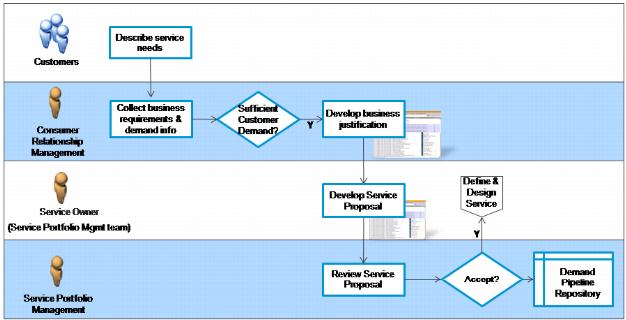7.2.1 Service Development Management
The process for Service Development Management enforces a structured approach to maintain quality and consistency during service development. The following sections describe the main process components.
7.2.1.1. Service Requirements
The Service Requirements process manages the interaction between the service development teams and business user during development of new services. A clear communication channel is set up and a standard service definition document template is created and used to capture business requirements. There is continuous review, and signoffs occur after every significant service development phase. This function requires analysis time for alignment with the Service Portfolio process. Business scenario and use cases are developed and a cost-benefit analysis is completed before service development begins.
Focus areas include the following:

Involvement of all necessary stakeholders.

Documentation of
business drivers and requirements that can be translated into appropriate service definitions and SLAs.
Clear definition of operational requirements along with alignment with appropriate service tiers
 Definition of
Definition of business scenarios and use cases.
 Definition of
Definition of the business users and roles that interact with services development so that user-centric services are created.

Workflow representation of the service to understand the components of the service, interactions, and sequence of interrelated actions.

Cost-benefit analysis (Internal versus external).
7.2.1.2. Service Requirements – Initiation Workflow
The following figure shows a sample service initiation workflow for creating a new service and the roles that are involved in the process.
Figure 13. Service Requirements Workflow
See Section 5, Organizing for vCloud Operations, for more information about the organization and roles.
7.2.1.3. Service Design
The Service Design process focuses on creating consistent architecture and design for new services. This function is responsible for creation of architecture blueprints and service templates for rapid service creation.
Key focus areas:

High-level design representation of the service in order to understand its components, interactions, and sequence of interrelated actions and expected SLAs.
 Integration and alignment with the
Integration and alignment with the s
ervice p
ortfolio and catalog process areas.
 Integration and alignment with the
Integration and alignment with the service showback and metering process.

Business user signoff on service design.
7.2.1.4. Service Design – Workflow
The following figure shows a sample service design workflow and the roles that are involved in the process.
Figure 14. Service Design Workflow
Se
e Section 5, Organizing for vCloud Operations, for more information about the organization and roles.
7.2.1.5. Service Development
The Service Development process focuses on the developing the services, and aligning service development methodologies for an organization. This function requires speed and agility to respond quickly to changing business needs. This function also manages and controls the overall service development environment, platforms, and tools used in the overall service development process.
Key focus areas:

Agility and rapid response.

Definition of service development methodology (In general,
Agile development is recommended).
 Integration and alignment with other operational
Integration and alignment with other operational process areas:
o Performance SLAs (application response time, bandwidth including burst, time to respond, time to resolution).
o Availability SLAs (uptime, backup, restore, data retention).
o Continuity SLAs (RPO, RTO).
o Scalability.
o Manageability (user account management, supportability).
o Security (application/data access, management/control access, user accounts, authentication/authorization).
o Compliance (regulatory compliance, logging, auditing, data retention, reporting).
 Alignment with the service showback
Alignment with the service showback and
metering management process for service costing, pricing, metering, and billing.
 Development of service
Development of service controls:
o Continual service reporting, service quality analysis, and trending.
o Automated remediation scripts and integration workflows.
7.2.1.6. Service Development – Workflow
The following figure shows a sample service development workflow and the roles that are involved in the process.
Figure 15. Service Development Workflow
See S
ection 5, Organizing for vCloud Operations, for more information about the organization and roles.
7.2.1.7. Common Service Development Characteristics
The following are common service development characteristics of a vCloud service.

On-demand self-
service – A vC
loud service needs to be designed and developed to allow for on-demand provisioning via a service catalog that uses automated workflows with minimal human interaction from the service’s provider side.
 Service mobility – Services should be designed to be accessible
Service mobility – Services should be designed to be accessible from
multiple end-
user computing mobility platforms such as tablets, phones and other thin or thick end-user platforms.

Resource pooling – Services should designed to be able to use pooled computing resources, not bound to physical infrastructure. There should be a sense of location independence—the service consumer generally has no control or knowledge over the exact location of the provided resources.

Rapid elasticity – Services should be able to use the vCloud elastic and bursting feature to support high utilization timeframes. Services should be designed to automatically scale and release computing resources.
 Measured service – Services must be designed with ability to
Measured service – Services must be designed with ability to leverage
metering capability based on service consumption. This is critical to make the service a viable business investment for the service provider. This feature is at the heart of the Service Showback and Metering process.

